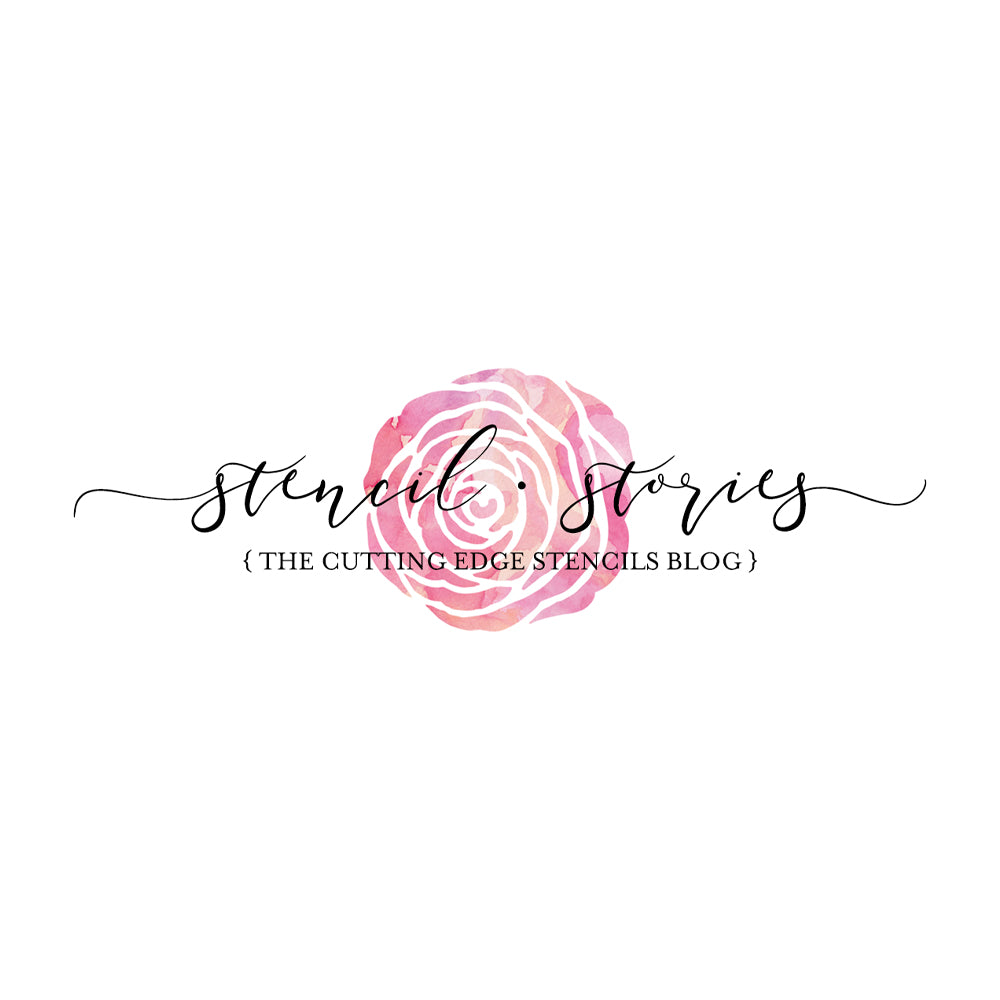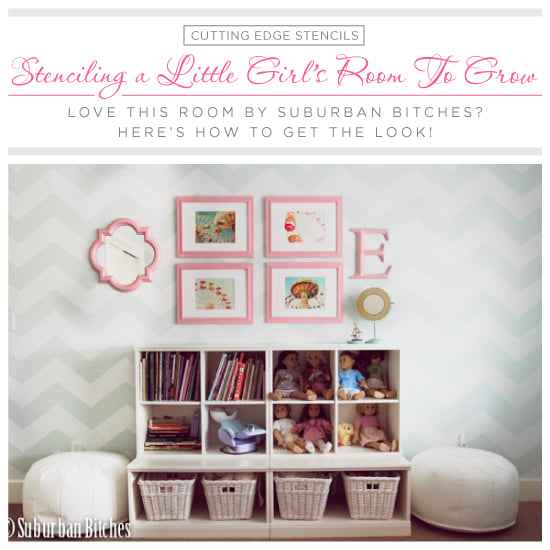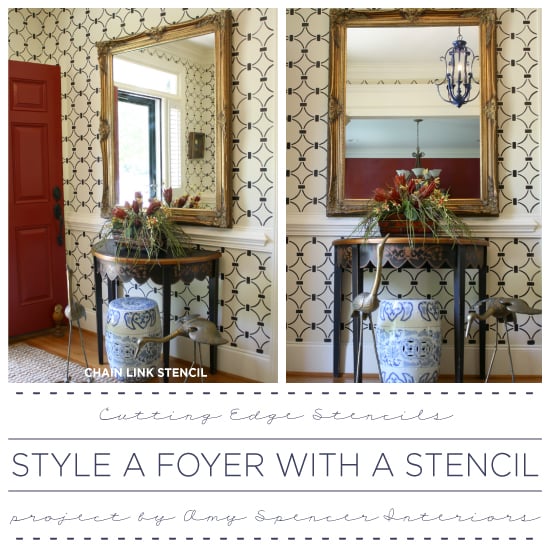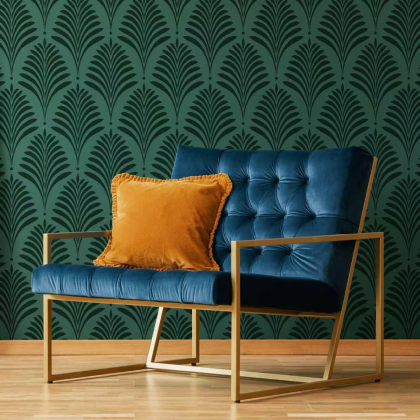Learn How to Stencil the Brick Allover Pattern
Step By Step Tutorial for Stenciling the NEW Brick Stencil
Happy Tuesday, my DIY stenciling friends! Cutting Edge Stencils hopes you enjoyed meeting our NEW stencil designs yesterday. If you haven't had a chance to browse the new collection then hop on over here and do so!For those of you who have had a chance to swoon over the latest and greatest, we know you've probably fallen for our new Brick Allover pattern. As hopeless romantics, we just LOVE the rustic, earthy look that brick can bring to a space. Faux brick patterns that emulate the real thing are all the rage. So if you’re just gaga over brick but you’re lacking in masonry skill then this trend is for you! This tutorial will help you better understand the process of painting the popular pattern.
Here’s What You’ll Need:
Cutting Edge Stencils’ Brick Allover pattern ~ Clip-on stencil level ~ Latex or Acrylic Paints, including some basecoat ~ Large Sponge or Sea Sponge ~ Paint Tray or Large Styrofoam Plates ~Paper towels ~ Stencil brush ~ Blue Painters tape ~ Tarp ~ Step Ladder
Here’s What You'll Do:

 Then offload the paint onto a paper towel by rolling it back and forth until the roller seems almost dry and the paint is evenly distributed. Too much paint can create leakage under the stencil. There should be no visible paint on a roller surface, it should look almost dry. Remember, it's better to have less paint on your roller than too much paint.
Then offload the paint onto a paper towel by rolling it back and forth until the roller seems almost dry and the paint is evenly distributed. Too much paint can create leakage under the stencil. There should be no visible paint on a roller surface, it should look almost dry. Remember, it's better to have less paint on your roller than too much paint.
 Start stenciling your wall using light to medium pressure on your dense foam roller. Pressing too hard will lead to bleeding and smudging. You can easily check how you're doing by carefully un-taping and lifting one corner of the stencil and taking a peek. Do you like what you see? If it's too pale, just put the stencil back and paint it a couple more times back and forth, slightly adding more. Let the 1st coat dry for a couple of minutes and then paint the stencil again.
Start stenciling your wall using light to medium pressure on your dense foam roller. Pressing too hard will lead to bleeding and smudging. You can easily check how you're doing by carefully un-taping and lifting one corner of the stencil and taking a peek. Do you like what you see? If it's too pale, just put the stencil back and paint it a couple more times back and forth, slightly adding more. Let the 1st coat dry for a couple of minutes and then paint the stencil again.
 To create more depth and interest, we've decided to use a sponge. If you don't have a natural sea sponge, you can use a house hold sponge but pick out some pieces to make it uneven.
To create more depth and interest, we've decided to use a sponge. If you don't have a natural sea sponge, you can use a house hold sponge but pick out some pieces to make it uneven.
 Randomly brush your second color (we have chosen brown) on the sponge.
Randomly brush your second color (we have chosen brown) on the sponge.
 Then move sporadically over the brick stencil. Make sure to change the position of your hand so that there is no distinct repeat pattern in your design.
Then move sporadically over the brick stencil. Make sure to change the position of your hand so that there is no distinct repeat pattern in your design.
 Gently remove the stencil and reposition the stencil to move down the wall. Simply line up your stencil with the previously painted parts, check your level, and continue.
Gently remove the stencil and reposition the stencil to move down the wall. Simply line up your stencil with the previously painted parts, check your level, and continue.
 Don't worry if it doesn't line up perfectly, and try not to roll over the previously painted areas.
Don't worry if it doesn't line up perfectly, and try not to roll over the previously painted areas.
 There's no need to clean the stencil in between repeats. Each stencil is good for many repeats before it will need to be cleaned. It's time to clean the stencil when your paint build-up starts to compromise the design. Continue to reposition your stencil until your entire wall is complete.
There's no need to clean the stencil in between repeats. Each stencil is good for many repeats before it will need to be cleaned. It's time to clean the stencil when your paint build-up starts to compromise the design. Continue to reposition your stencil until your entire wall is complete.
 Once the wall is complete, remove the stencil. Then dilute a small amount of dark brown or black paint with a touch of water in a cup or foam plate. For this, we used Benjamin Moore's brown horse 2108-30. Dip the edges of your toothbrush or stencil brush and "flick" the bristles so that the color sprays off the brush and onto the wall. Spatter the painted brick randomly.
Once the wall is complete, remove the stencil. Then dilute a small amount of dark brown or black paint with a touch of water in a cup or foam plate. For this, we used Benjamin Moore's brown horse 2108-30. Dip the edges of your toothbrush or stencil brush and "flick" the bristles so that the color sprays off the brush and onto the wall. Spatter the painted brick randomly.

 This gives the brick some interest and a realistic look. Now let's stand back and look at the great job you have done!
This gives the brick some interest and a realistic look. Now let's stand back and look at the great job you have done!
 Gorgeous, right!
Gorgeous, right!
Tell us, where would you use this trendy Brick pattern? Leave us a comment below!
For more stenciling fun:- Check out our new stencil designs on the Cutting Edge Stencils website!
- Follow us on Pinterest and Instagram to see awesome inspirational photos!
- Have you completed a stencil project? Come share it on Facebook!







